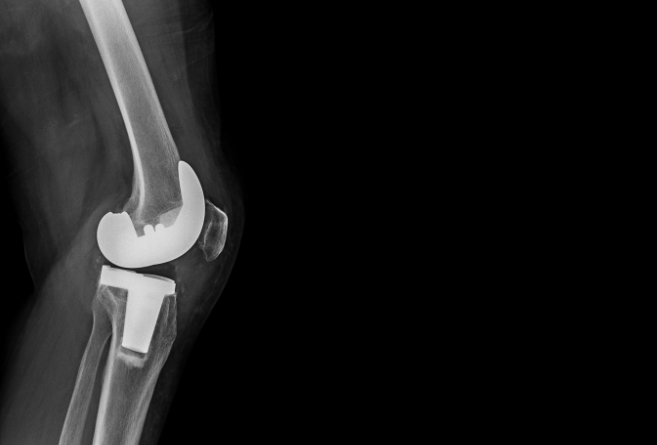You have found yourself on the other side of a successful total knee replacement surgery! Awaiting you is a journey to full recovery and this can be an intimidating thing to think about. Your medical team has sent you home with a boat load of instructions, things to watch out for and activities to avoid. Who wouldn’t be overwhelmed? While there are many benefits to being cautious and aware during your recovery, this can sometimes cause you to worry about signs and symptoms that are actually completely normal following a knee replacement. The purpose of this blog is not to point out complications or signs of concern to watch out for after surgery. Click here to read about on blog about potential complications. This blog aims to remind you about the VERY NORMAL signs and symptoms that you may experience following your knee replacement surgery that should not be a cause for concern.

Image by ภาพของJiggo_Putter Studio via Canva - Experiencing some redness, swelling and bruising is a very normal part of the knee replacement recovery
1) Redness, Swelling & Bruising
The knee replacement recovery process begins as soon as the surgery is complete. Let’s not forget that the surgery entailed a surgeon replacing the worn ends of your thigh and leg bones with plastic and metal parts. Your knee joint has gone through quite a bit! Experiencing some redness, swelling and bruising is actually a very normal part of the healing and recovery process. In most cases swelling can last for 2 to 3 weeks after your surgery but can also persist for as long as 3 to 6 months. [1] Click here for some great tips on how to manage swelling. Redness and slight bruising may last between 1 to 2 weeks following your surgery. [1] The first phase of our body’s natural healing process is known as the inflammatory phase. The signs mentioned above are signs of this phase and are a part of our body’s way of dealing with injury. However, if redness, swelling and bruising persists for several months following surgery or appears in excessive amounts it is worth mentioning to your healthcare provider.
2) Reduced Knee Movement
The strength in your quadricep muscles (the group of muscles at the front of your thigh) is something that is known to get worse as osteoarthritis progresses.[2] This basically means that you already have lost a lot of strength in your quads even before having your surgery. Following your total knee replacement, the quads will experience an even greater reduction in strength. [2] Your quads are responsible for movements that require the straightening of your knee. This means that it is completely normal to have reduced strength and movement when it comes to straightening out your knee. Luckily, this movement is one of the greatest focuses of rehabilitation following your knee replacement surgery. Achieving full straightening of the knee can take anywhere between 1 week to even 2 months after surgery. [3]
Image by Edward Olive via Canva - Reduced knee strength and knee movement is normal after knee replacement surgery
Knee Flexion (Bending your knee)
Your hamstrings are another muscle group (the ones at the back of your thigh) that have been shown to have reduced strength after a knee replacement surgery. [2] This muscle group is responsible for helping you with movements that require bending of the knee. It is normal to take around 7 to 10 days to bend your knees up to the 90 degree mark. This is enough to help with simple activities like standing, walking and maybe some stair climbing with support. However, it is important to remember that getting to greater levels of knee bending TAKES TIME! It is normal to take 3 months or sometimes even more to reach about 115 degrees of knee bending. [4]
While reduced muscle strength definitely contributes to the decreased range of motion in your knee, this is only a part of the full picture. There are several other factors, many of which are discussed in this blog, that also contribute to reduced knee movement. Increased swelling, pain and fear all contribute to a loss of knee joint movements. So when all these contributing factors come together it makes sense that your knee is not bending and straightening as it use to. Remember that everyone naturally has different degrees of movement available in their knee joint! The guidelines and protocols you read online are evidence based targets that you can definitely work towards achieving. The point is to remember that it is completely normal to take a couple of weeks or even months before you can move your knee the same way you could before surgery. In many cases, people can move their knee even better than prior to their knee repalcement.
3) Clicking
Clicking or popping sounds are a very normal side effect of knee replacement surgeries. The noise you hear is most likely coming from the metal or plastic parts of your knee replacement adjusting inside of your leg. It could also potentially be the movement of your muscles and tendons adjusting to the new knee implant. [5] Movements that usually cause this sound involve knee bending; it also can be heard during walking. [5] It might take several months for the clicking sound to completely disappear as it is a result of your body getting use to movement with the implant. [6] Clicking alone should not be a cause of concern, however if it is paired with sharp, intense pain or other noises it is definitely worth mentioning to your healthcare provider.

Image by Choochin via Canva - The click you hear is most likely coming from the metal or plastic parts of your knee replacement adjusting inside of your leg
4) Pain & Heaviness
Other symptoms common after a total knee replacement surgery include pain and a feeling of heaviness in your knee. Pain is unfortunately a very normal symptom following knee replacement, especially in the first 3-6 months. [7] Over time pain will definitely improve as you continue with your rehabilitation and recovery. Click here to read in detail about the pain experience after knee replacement surgery. Overall your knee will feel a little “weird” or heavy after surgery but this too is completely normal. Check out this amazing blog that explains why your knee may feel "weird" after your knee replacement.
Conclusion
A knee replacement surgery is a major surgical procedure. As a result, you will experience symptoms and side effects for a few months after your surgery is complete. The important thing to remember here is that most of these symptoms are COMPLETELY NORMAL. Common things that you might experience can include:
1)Redness, Swelling & Bruising
2)Reduced Strength & Movement
3)Clicking/Popping Noises
4)Pain and Heaviness
These are all very common signs seen in healing and recovery.
Curovate is a mobile app for people recovering after a knee replacement. Find all of this useful information about normal signs and symptoms after surgery along with daily video guided exercises. Download Curovate using the links below.
 |
 |
|---|
Other Blogs Related to Knee Replacement
- Common Complications After Surgery - What to Watch Out for to Keep Yourself Healthy!
- Ice, compression, elevation and ankle pumps
- Is it normal to still have pain after a knee replacement surgery?
- Why does my knee feel weird after my total knee replacement? Why does my knee feel heavy after my total knee replacement?
References
3. UCONN Health Musculoskeletal Institute After Total Knee Replacement Postoperative Instructions
5. American Academy of Orthopedic Surgeons: Total Knee Replacement







